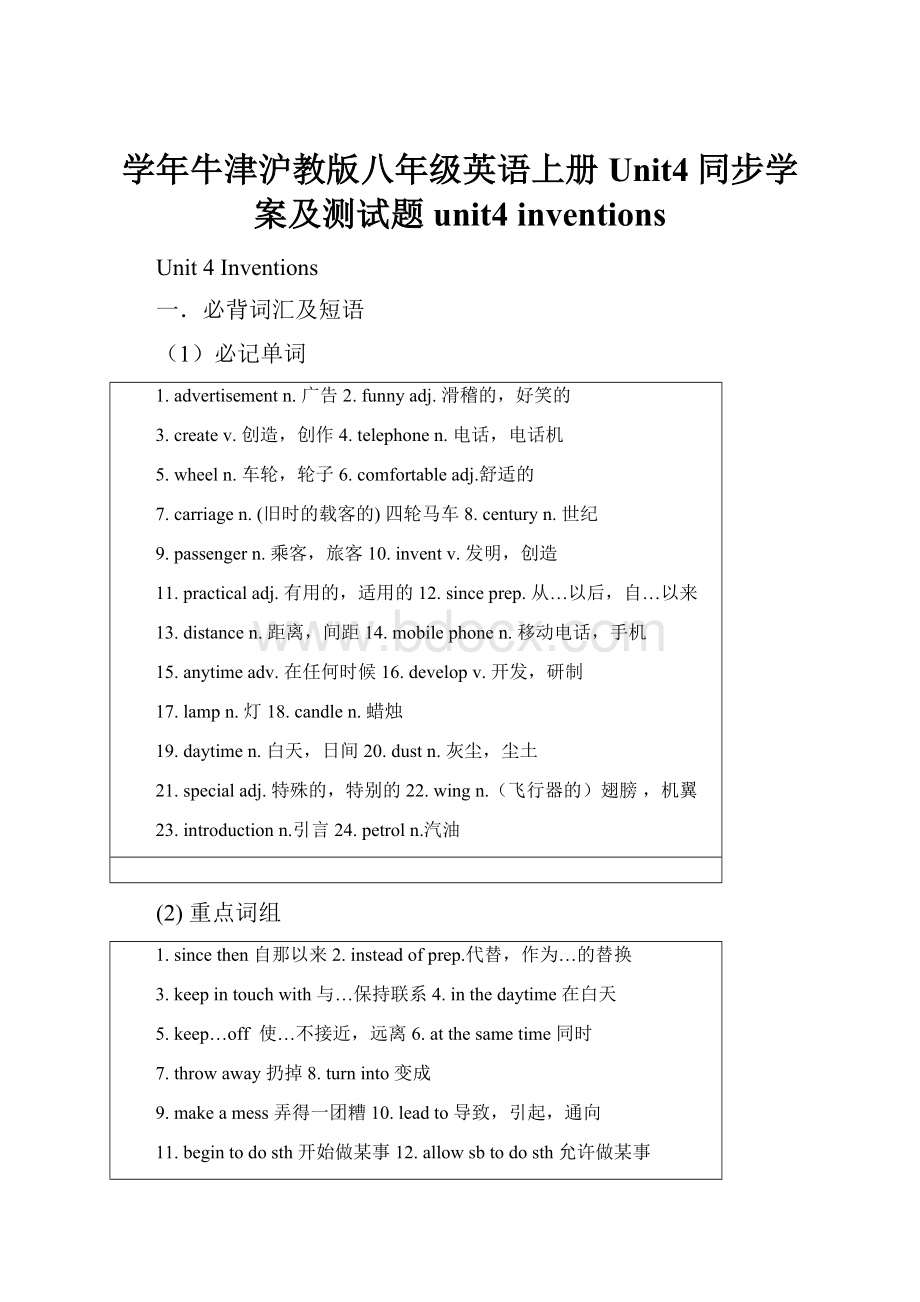学年牛津沪教版八年级英语上册Unit4同步学案及测试题 unit4 inventions.docx
《学年牛津沪教版八年级英语上册Unit4同步学案及测试题 unit4 inventions.docx》由会员分享,可在线阅读,更多相关《学年牛津沪教版八年级英语上册Unit4同步学案及测试题 unit4 inventions.docx(30页珍藏版)》请在冰豆网上搜索。

学年牛津沪教版八年级英语上册Unit4同步学案及测试题unit4inventions
Unit4Inventions
一.必背词汇及短语
(1)必记单词
1.advertisementn.广告2.funnyadj.滑稽的,好笑的
3.createv.创造,创作4.telephonen.电话,电话机
5.wheeln.车轮,轮子6.comfortableadj.舒适的
7.carriagen.(旧时的载客的)四轮马车8.centuryn.世纪
9.passengern.乘客,旅客10.inventv.发明,创造
11.practicaladj.有用的,适用的12.sinceprep.从…以后,自…以来
13.distancen.距离,间距14.mobilephonen.移动电话,手机
15.anytimeadv.在任何时候16.developv.开发,研制
17.lampn.灯18.candlen.蜡烛
19.daytimen.白天,日间20.dustn.灰尘,尘土
21.specialadj.特殊的,特别的22.wingn.(飞行器的)翅膀,机翼
23.introductionn.引言24.petroln.汽油
(2)重点词组
1.sincethen自那以来2.insteadofprep.代替,作为…的替换
3.keepintouchwith与…保持联系4.inthedaytime在白天
5.keep…off使…不接近,远离6.atthesametime同时
7.throwaway扔掉8.turninto变成
9.makeamess弄得一团糟10.leadto导致,引起,通向
11.begintodosth开始做某事12.allowsbtodosth允许做某事
13.imaginedoingsth想象做某事14.makesbdosth使某人做某事
15.feel+adj觉得…
(3)重点句子:
1.Afteritsinvention,travellingbecamefasterandmorecomfortable.在它发明之后,旅游就变得更快更舒服了。
2.Intheearly19thcentury,thefirsttrainsbegantocarrypassengers.在19世纪早期,第一批火车开始载乘客。
3.Atthestartofthe20thcentury,carsbecamepopular.在20世纪初,小汽车变得流行起来。
4.Sincethen,peoplehavebeenabletospeakeachotheroverlongdistances.自从那时起,人们就能和很遥远的人彼此通话。
5.Theyallowpeopletokeepintouchwitheachotheranytime,anywhere.他们允许任命随时随地保持联系。
6.Withlightbulb,peoplecandoasmanythingsintheeveningastheycaninthedaytime.用灯泡,人们可以在晚上做与白天一样多的事。
一.必背词汇及短语
单词
1.广告______2.funnyadj.______→n.
3.createv.__________=→n______4.电话______
5.wheeln.______6.舒适的adj.______→adv.______→n.
7.carriagen.______8.centuryn.______
9.passengern.______=
10.inventv.→n.(发明家)→n.(发明物)
11.practicaladj.12.sinceprep.
13.distancen.→adj.→adv.
14.mobilephonen.15.anytimeadv.
16.developv.→n.developed/developing/
17.lampn.=18.candlen.
19.daytimen.20.dustn.
21.specialadj.→adv.22.wingn.
23.introductionn.→v.
24.petroln.
短语
1.sincethen2.insteadof
3.keepintouchwith4.inthedaytime
5.keep…off6.atthesametime
7.throwaway8.turninto
9.makeamess10.leadto
11.begintodosth12.allowsbtodosth
13.imaginedoingsth14.makesbdosth
15.feel+adj16.电灯泡
17.过好的生活18.在19世纪
知识点讲解
1.AlexanderGrahamBellinventedoneofthefirstpracticaltelephonesin1786
发明;创造
invent&discover辨析
invent 意为“发明”,发明之物是“从无到有”,如:
Modernfootballwas invented byBritish.
discover 意为“发现”,发现“本来就已经存在,但不为人知”的事物,如:
Columbus discovered America in 1492
2.Sincethen,peoplehavebeenabletospeaktoeachotheroverlongdistance..
be able to 表示“能”、“会”时,与can可互换,意义差别不大。
be able to与 can 区别
1)can could 表示能力;可能 (过去时用could),
只用于现在式和过去式(could)。
be able to可以用于各种时态。
can 除可以表示“能”、“会”外,还可以表示“许可”、“允许”或可能性,而 be able to 则不可
They will be able to tell you the news soon.
2)只用be able to a. 位于助动词后。
b. 情态动词后。
can 与 be able to 不能重叠使用
Over/through/across通过,穿过
over是介词,用作“穿过、通过”时,表示到达高的障碍物(如树、墙、篱笆和山脉等)的另一侧
across表示横过,即从物体表面通过,与on有关,为二维
through穿过,即从物体内部穿过,与in有关,为三维。
1.speak强调单方的“说”或“讲”并且强调的是说的动作,一般用作不及物动词,要表示“对某人说(某事)”,可用speakto/withsb(aboutsth)。
speak+语言。
如:
SpeakEnglishinmyclass,please.
Ispoketo/withthechairmanaboutmyidea.
2.talk意为“讲、谈论,谈话”是不及物动词,,表示“同某人谈论(某事)”,可用talkto/withsb(aboutsth)。
如:
Hewastalkingto/withafriend.
3.say强调说话内容,一般用作及物动词。
表示“对某人说”,可用saytosb。
Itissaidthat...意为“据说”。
如:
Itissaidthathecouldstayunderthewaterforalongtime.如:
Didyousayanything(tohim)?
注:
以下句型值得注意:
据说他病了。
正:
Itissaidthatheisill.正:
Heissaidtobeill.
4.tell表示“告诉”,可tellsbsth./tellsthtosb.告诉某人某事。
如:
tellsbsth./tellsthtosb.
Hetoldhisparentsthegoodnews./Hetoldthegoodnewstohisparents.
注:
还可接不定式的复合结构作宾语,tellsbtodosth叫某人做某事。
如:
Hetoldthechildrennottoplayinthestreet.
另外,有时与介词from连用表示“区分”“辨别”等。
如:
Canyoutelltruefriendsfromfalsefriends?
3.Theyallowpeopletokeepintouchwitheachotheranytime,anywhere.
Allow:
允许
allow的用法
1. allow (doing) sth 允许(做)某事。
如:
We don’t allow eating in the classrooms. (我们)不允许在教室吃饭。
注:
有时用于被动语态。
Smoking is not allowed here.
2. allow sb ____ sth 允许某人做某事。
如:
My parents don’t allow me to go out at night.
4.Keepthedustoffyourshoes.
用作系动词,意为“保持(某种状态)”,其后常接形容词作表语。
如:
坚持;继续。
后面如接动词,要用 V-ing 形式作宾语。
如:
If you keep (on) practising your spoken English, you'll soon make great progress.
阻止;阻碍。
常用于 keep sb/sth from doing sth 结构中,其中介词 from 不能省略。
如:
The heavy rain didn't keep them from watching the football match
keep + sb/sth + 形容词。
如:
These gloves will keep your hands warm.
5.TheBlacksthrowasmanyascanstheBrowns
TheBlacks;布莱克一家。
the+姓氏的名词复数,表示“一家人”或“夫妻俩”
Asmanyas:
多达;和...一样多;后接可数名词复数;asmuchas;多达;和...
一样多;后接不可数名词
6.Itsometimesmadeamessonthepaper.
1)Sometimes “有时”,提问时用how often
如:
He sometimes walks to school.
2)Sometime“某个时候”,提问时用when
如:
I will go to Beijing sometime next week..
3)some times“几次”,提问时用how many times
如:
I have been to Japan some times.
4)some time“一段时间”,提问时用how long
如:
I stayed in Shanghai for some time.
7.ThomasEdisondevelopedthefirstpracticallightbulbin1789
Develop:
开发,研制;发展;冲洗;
Develop:
v.发展;形容词:
developed发达的;developing发展中的;欠发达的;名词为development。
Americaisthebiggestdevelopedcountrywhilechinaisthebiggest
developingcountry
8.Zhugeliangusedsuchlanternstogivesignalsinbattles.
Usesthtodosth;usesthfordoingsth;dosthwithsth用某物做某事
Such如此的(与that连用)
区别such与so
1.so+adj/adv.+that
e.g:
HerunssofastthatIcan’tcatchhim.
2so+many/few+可数名词复数/much/little+不可数名词that
e.g:
Sofewpeoplecametoseethefilmthatthemangerputonanotherfilminstead.
3.such+a/an+adj.+n.单数=so+sdj+a/an+n.单数(形容词的位置不同)
(Theboyissuchayoungboythathecan’tgotoschool.)
4.such+adj+复数\不可数+that
e.g:
Hetoldussuchfunnystoriesthatwealllaughed.
.9...wemakeourvoiceriseattheend
.sound,voice与noise
相同点:
它们均有“声音”的意思。
不同点:
sound“声音”,泛指人能听到的自然界的声音;
voice“噪音”,只人说话,唱歌或鸟鸣叫的声音;
niose“噪音,吵闹声”,常指不悦耳,不和谐的嘈杂声。
如:
The room is very quite you can’t hear any sound.
The girl is singing in a beautiful voice.
Don’t make any noise -your father is sleeping.
10.Afteritsinvention,travellingbecamefasterandmorecomfortable.
Comfortable:
舒适的;形容词;动词为comfort;其比较级morecomfortable.
最高级为mostcomfortable;反义词为uncomfortable
Thesofatouchesmorecomfortablethanthatone.
Hefeelsuncomfortable;hewantstogohomenow.
知识点讲解(填写版)
1.AlexanderGrahamBellinventedoneofthefirstpracticaltelephonesin1786
invent发明;创造;其名词为:
______发明、______发明家
invent&discover辨析
invent 意为“发明”,发明之物是“从无到有”,如:
Modernfootballwas invented byBritish.
discover 意为“发现”,发现“本来就已经存在,但不为人知”的事物,如:
Columbus discovered America in 1492
2.Sincethen,peoplehavebeenabletospeaktoeachotheroverlongdistance..
be able to 表示“能”、“会”时,与______可互换,意义差别不大。
be able to与 can 区别
1)can could 表示能力;可能 (过去时用______),
只用于现在式和过去式(could)。
be able to可以用于各种时态。
can 除可以表示“能”、“会”外,还可以表示“许可”、“允许”或可能性,而 be able to 则不可
They will be able to tell you the news soon.
2)只用be able to a. 位于助动词后。
b. 情态动词后。
can 与 be able to 不能重叠使用
Over/through/across通过,穿过
over是介词,用作“穿过、通过”时,表示到达高的障碍物(如树、墙、篱笆和山脉等)的另一侧
across表示横过,即从物体______通过,与on有关
through穿过,即从物体______穿过,与in有关
1.speak强调单方的“说”或“讲”并且强调的是说的动作,一般用作不及物动词,要表示“对某人说(某事)”,可用speak______/______sb(aboutsth)。
speak+语言。
如:
SpeakEnglishinmyclass,please.
Ispoketo/withthechairmanaboutmyidea.
2.talk意为“讲、谈论,谈话”是不及物动词,,表示“同某人谈论(某事)”,可用talk______/______sb(______sth)。
如:
Hewastalkingto/withafriend.
3.say强调说话内容,一般用作及物动词。
表示“对某人说”,可用saytosb。
Itissaidthat...意为“据说”。
如:
Itissaidthathecouldstayunderthewaterforalongtime.如:
Didyousayanything(tohim)?
注:
以下句型值得注意:
据说他病了。
正:
Itissaidthatheisill.正:
Heissaidtobeill.
4.tell表示“告诉”,可tellsbsth./tellsth______sb.告诉某人某事。
如:
Hetoldhisparentsthegoodnews./Hetoldthegoodnewstohisparents.
注:
还可接不定式的复合结构作宾语,tellsb______sth叫某人做某事。
如:
Hetoldthechildren______(notplay)inthestreet.
另外,有时与介词from连用表示“区分”“辨别”等。
如:
Canyoutelltruefriendsfromfalsefriends?
3.Theyallowpeopletokeepintouchwitheachotheranytime,anywhere.
Allow:
允许
allow的用法
1. allow (______) sth 允许(做)某事。
如:
We don’t allow eating in the classrooms. 注:
有时用于被动语态。
Smoking is not allowed here.
2. allow sb ____ sth 允许某人做某事。
如:
My parents don’t allow me to go out at night.
4.Keepthedustoffyourshoes.
用作系动词,意为“保持(某种状态)”,其后常接形容词作表语。
如:
坚持;继续。
后面如接动词,要用 V-ing 形式作宾语。
如:
If you keep (on) practising your spoken English, you'll soon make great progress.
阻止;阻碍。
常用于 keep sb/sth from doing sth 结构中,其中介词 from 不能省略。
如:
The heavy rain didn't keep them from watching the football match
keep + sb/sth + 形容词。
如:
These gloves will keep your hands warm.
5.TheBlacksthrowasmanyascanstheBrowns
TheBlacks;布莱克一家。
the+姓氏的名词复数,表示“一家人”或“夫妻俩”
谓语用复数形式
TheKings______(watch)TVnow
Asmanyas:
多达;和...一样多;后接______;asmuchas;多达;和...
一样多;后接______
6.Itsometimesmadeamessonthepaper.
1)Sometimes “有时”,提问时用______
如:
He sometimes walks to school.
2)Sometime“某个时候”,提问时用______
如:
I will go to Beijing sometime next week..
4)some times“几次”,提问时用______
如:
I have been to Japan some times.
4)some time“一段时间”,提问时用______
如:
I stayed in Shanghai for some time.
7.ThomasEdisondevelopedthefirstpracticallightbulbin1789
Develop:
开发,研制;发展;冲洗;
Develop:
v.发展;形容词:
______发达的;______发展中的;欠发达的;名词为______。
Americaisthebiggestdevelopedcountrywhilechinaisthebiggest
developingcountry
8.Zhugeliangusedsuchlanternstogivesignalsinbat